The Health Education Assets Library (HEAL) is a collection of over 22,000 freely available digital materials for health sciences education. The collection is now housed at the University of Utah J. Willard Marriott Digital Library.
TO
Filters: Collection: "ehsl_heal"
| Title | Description | Subject | Collection | ||
|---|---|---|---|---|---|
| 1 |
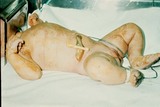 |
Post-term MAS infant | Post-term Meconium Aspiration Syndrome (MAS) infant with barrel chest and in need for oxygen; shows signs of postmaturity (peeling skin) and air-trapping (increased anterior-posterior diameter). | Air Trapping; Anterior-Posterior Chest Diameter; Barrel Chest | Harris Pediatric Image Collection |
| 2 |
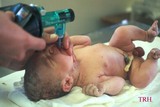 |
Manual ventilation during successful delivery room resuscitation | Manual ventilation during successful delivery room resuscitation of a meconium-stained, initially depressed, postmature newborn infant male. | manual ventilation | Harris Pediatric Image Collection |
| 3 |
 |
Typical post-term meconium-stained infant receiving conventional mechanical ventilation | A typical post-term, meconium-stained infant receiving conventional ventilation for MAS complicated by right-sided peumothorax and requiring chest tube decompression and drainage. | mechanical ventilation; chest tube decompression | Harris Pediatric Image Collection |
| 4 |
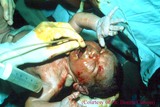 |
Further suctioning of MAS infant before first breath taken | Further suctioning of Meconium Aspiration Syndrome (MAS) infant before baby takes his/her first breath. | Mouth Suctioning | Harris Pediatric Image Collection |
| 5 |
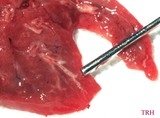 |
Wet hepatisized lung at autopsy | Wet hepatisized lung at autopsy of infant dying of Type II Meconium Aspiration Syndrome (MAS). | Type II MAS | Harris Pediatric Image Collection |
| 6 |
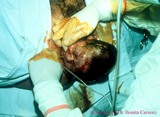 |
Suctioning of the mouth in MAS infant before delivery of the body | Suctioning of the mouth of infant with Meconium Aspiration Syndome (MAS) before delivery of the body. | Mouth Suctioning | Harris Pediatric Image Collection |
| 7 |
 |
Suctioning of the perineum in a case of birth through meconium-stained amniotic fluid | Suctioning of the perineum in a case of birth through meconium-stained amniotic fluid; the nose is the first to appear. | perineum suctioning | Harris Pediatric Image Collection |
| 8 |
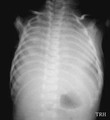 |
Anterior-posterior chest X-ray of meconium-stained severely asphyxiated infant | Anterior-posterior X-ray of meconium-stained severely asphyxiated infant with Type II Meconium Aspiration Syndrome (MAS) and shock lung (ARDS). | Anterior-Posterior Chest Diameter; Type II MAS; Shock Lung | Harris Pediatric Image Collection |
| 9 |
 |
Aspiration of particulate matter (meconium) producing ball-valve mechanism and air-trapping with subsequent air leak complication | Aspiration of particulate matter (meconium) producing ball-valve mechanism and air-trapping with subsequent air leak complication. If bronchus is only partially occluded during inspiration (A) when airways are dilated due to low intrathoracic pressure (represented by black arrows), gas may enter but... | Ball-Valve Mechanism; Air Trapping; Intrathoracic Pressure | Harris Pediatric Image Collection |
| 10 |
 |
Anterior-posterior X-ray taken shortly after birth of infant with Type II MAS | Anterior-posterior chest X-ray taken shortly after birth of baby with Type II Meconium Aspiration Syndrome (MAS). | Anterior-Posterior Chest Diameter; Air Trapping; Type II MAS | Harris Pediatric Image Collection |
| 11 |
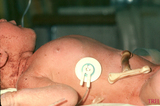 |
Increased AP-diameter of chest in MAS infant due to air-trapping | Increased AP-diameter of chest in infant with Meconium Aspiration Syndrome (MAS) due to air-trapping. | Air Trapping; Anterior-Posterior Chest Diameter | Harris Pediatric Image Collection |
| 12 |
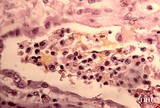 |
Meconium debris and inflammatory cells in occluded terminal bronchiole | Meconium debris and inflammatory cells in occluded terminal bronchiole in case of lethal prenatal aspiration of meconium-stained amniotic fluid. | Inflammatory Cells; Prenatal Aspiration | Harris Pediatric Image Collection |
| 13 |
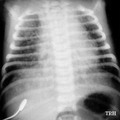 |
Chest X-ray of (MAS) infant with severe Type I Meconium Aspiration Syndrome prior to respiratory failure | Chest X-ray of baby with severe Type I Meconium Aspiration Syndrome (MAS) just prior to respiratory failure (RF) requiring mechanical ventilation - noting patchy infiltrates or areas of atelectasis scattered throughout markedly over-expanded lungs (predominantly on the right) due to air-trapping. | Air Trapping; Respiratory Failure; Infiltrates | Harris Pediatric Image Collection |
| 14 |
 |
Anterior-posterior chest X-ray of same MAS infant | Anterior-posterior chest X-ray of same Meconium Aspiration Syndrome (MAS) baby now on conventional mechanilcal ventilation - note worsening air-trapping. | Air Trapping; Anterior-Posterior Chest Diameter | Harris Pediatric Image Collection |
| 15 |
 |
Meconium aspirator | Meconium aspirator attaches to standard 15mm ET tube adaptor at one end (A) and wall suction line on the other (B). | Meconium Aspirator | Harris Pediatric Image Collection |
| 16 |
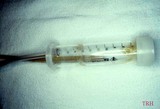 |
Meconium-stained mucus in DeLee Trap | Meconium-stained mucus in DeLee Trap. | DeLee Trap | Harris Pediatric Image Collection |
| 17 |
 |
Lumbar Puncture Step by Step | This video is a tutorial covering all aspects of performing the lumbar puncture procedure (LP). Learning Objectives: 1. List the indications and contraindications for performing an LP. 2. Describe the risks associated with performing an LP. 3. Demonstrate how to properly position the patient for t... | Lumbar Puncture; Spinal Tap; Intrathecal Chemotherapy | HEAL Reviewed Collection |
| 18 |
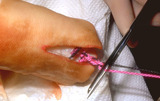 |
Suturing | After placing four throws to create a square knot, the suture is then cut just above the knot. | Knowledge Weavers Dermatology | |
| 19 |
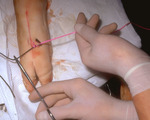 |
Suturing | The suture is then tightened by crossing the non-dominant (left) hand over the dominant (right) hand. | Knowledge Weavers Dermatology | |
| 20 |
 |
Suturing | This demonstrates tightening of the double loop along the long axis of the wound using suture. | Knowledge Weavers Dermatology | |
| 21 |
 |
Somatotropinoma | Somatotropinoma | Knowledge Weavers Pathology | |
| 22 |
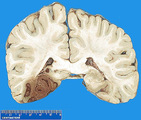 |
Recent hemorrhagic infarction | Recent hemorrhagic infarction | Knowledge Weavers Pathology | |
| 23 |
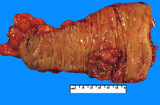 |
Adenocarcinoma, colon | Adenocarcinoma, colon | Knowledge Weavers Pathology | |
| 24 |
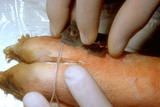 |
Shave technique | This demonstrates a shave technique on a pig's foot. Because there are no protruding lesions, I start by angling the blade at about 45 degrees from the skin surface, and while advancing the blade forward, I have a slight side to side sawing motion, and when I am about halfway through the target, I t... | Shave Biopsy | Knowledge Weavers Dermatology |
| 25 |
 |
Urticaria | This patient has developed rather severe urticaria, the cause of which was unknown. In urticaria, the skin swells and initially looks red and later can blanch as the amount of fluid increases within the skin. Internal organs can be involved in the process, and we are particularly concerned about the... | Knowledge Weavers Dermatology |
